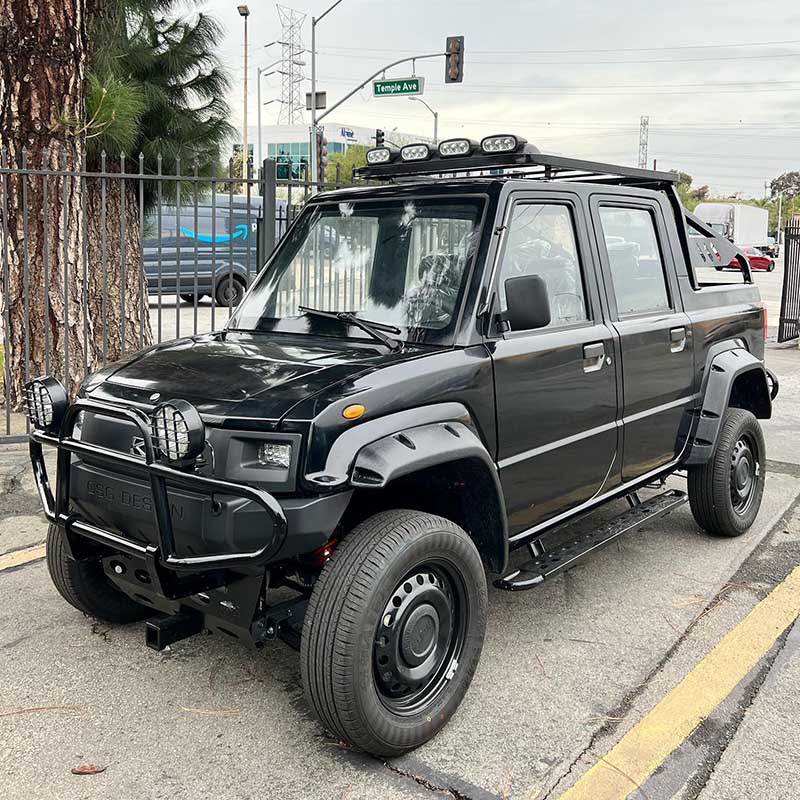Maintenance Requirements for the 4-Seat Electric Mini Pickup Truck
2024-05-23
The rise of electric vehicles (EVs) has brought a new paradigm to vehicle maintenance. The 4-seat electric mini pickup truck, combining the utility of a traditional pickup with the benefits of electric power, promises reduced maintenance compared to its gas-powered counterparts. However, it’s essential to understand the specific maintenance needs to ensure longevity and optimal performance. Here, we explore what kind of maintenance is required for these innovative vehicles.
Routine Maintenance Overview
1. Battery Health and Management
- Battery Inspection: Regularly inspect the battery for any signs of damage or wear. This includes checking for any swelling, leaks, or corrosion around the terminals.
- Battery Cooling System: Ensure that the battery’s thermal management system is functioning correctly. This system regulates the battery temperature to prevent overheating and extend battery life.
- Software Updates: Keep the vehicle’s software updated to ensure that the battery management system operates efficiently. Manufacturers frequently release updates that can improve battery performance and longevity.
2. Brake System
- Brake Fluid: While EVs utilize regenerative braking, which reduces wear on the brake pads, it’s still important to check and replace the brake fluid periodically. Follow the manufacturer’s guidelines for specific intervals.
- Brake Pads and Rotors: Inspect brake pads and rotors for wear. Regenerative braking reduces the frequency of replacements, but they should still be checked regularly, especially if the vehicle is used in hilly or mountainous areas.
3. Tire Maintenance
- Tire Rotation: Rotate the tires every 5,000 to 7,500 miles to ensure even wear. Proper rotation extends the life of the tires and improves the vehicle’s performance.
- Tire Pressure: Regularly check tire pressure and maintain it according to the manufacturer’s recommendations. Proper tire pressure is crucial for safety, efficiency, and tire longevity.
- Tire Alignment and Balance: Ensure the tires are correctly aligned and balanced. Misalignment can cause uneven tire wear and affect the vehicle’s handling.
4. Cooling Systems
- Coolant Levels: Check and maintain coolant levels for the battery, electric motor, and power electronics. Unlike traditional vehicles, EVs have multiple cooling systems that need regular monitoring.
- System Flushing: Periodically flush the cooling systems to remove any debris or contaminants that could hinder performance.
5. Software and Electronics
- Software Updates: Regularly update the vehicle’s software. Updates can enhance performance, improve battery management, and add new features.
- Electrical System Check: Inspect the vehicle’s electrical systems, including wiring and connections, to ensure everything is in good working order.
Long-Term Maintenance
1. Battery Replacement
- Over time, the battery capacity may diminish. While most batteries are designed to last over 100,000 miles or 8-10 years, they will eventually need replacement. Monitor the battery’s health regularly to anticipate when it might need replacing.
2. Motor and Inverter
- Motor Inspection: Electric motors require less maintenance than internal combustion engines, but they should still be inspected periodically for any signs of wear or issues.
- Inverter Maintenance: The inverter, which converts DC power from the battery to AC power for the motor, should be checked regularly to ensure it operates efficiently.
3. Chassis and Suspension
- Suspension Components: Regularly inspect suspension components for wear and tear, especially if the vehicle is used frequently on rough terrains.
- Chassis Inspection: Check the chassis for any signs of rust or damage, particularly in areas exposed to harsh weather conditions.
Additional Considerations
1. Cabin Air Filter
- Replace the cabin air filter every 15,000 to 30,000 miles, or as specified by the manufacturer. This helps maintain air quality inside the vehicle.
2. Wiper Blades
- Inspect and replace wiper blades as needed to ensure clear visibility during adverse weather conditions.
3. Lighting Systems
- Regularly check all lights, including headlights, taillights, and indicator lights, to ensure they are functioning correctly.
4. Service Intervals
- Follow the manufacturer’s recommended service intervals. Regular check-ups by a professional technician can help catch potential issues early and keep the vehicle running smoothly.
Conclusion
Maintaining a 4-seat electric mini pickup truck is generally less intensive than maintaining a traditional gas-powered vehicle. With fewer moving parts, no oil changes, and reduced brake wear due to regenerative braking, the maintenance requirements are simpler and less frequent. However, it is crucial to stay on top of battery health, software updates, and regular inspections of key components to ensure the vehicle remains reliable and performs optimally. By following these guidelines, owners can enjoy the many benefits of their electric mini pickup truck with minimal hassle.



